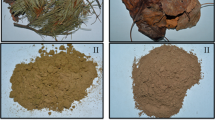Abstract
A new physical and mathematical formulation for the extinguishing of a forest fire with an inhibitor solution distributed using an explosive charge is proposed in this paper. It is assumed that the water and inhibitor are in the liquid-dispersion state and move together with the medium. The inhibitor allows the disruption of exothermic reactions, while being partially consumed. The results of numerical simulations have shown that the presence of an inhibitor makes it possible to reduce the required mass of the extinguishing composition for the successful suppression of a forest fire. It is shown that these results are in good agreement with known experimental data on the efficiency of replacing pure water with an inhibitor solution.






Similar content being viewed by others
REFERENCES
Abduragimov, I.M., Govorov, V.Yu., and Makarov, V.E., Fiziko-khimicheskie osnovy razvitiya i tusheniya pozharov (Fire Development and Suppression: Physicochemical Base), Moscow: Higher Engineering Fire Technical School USSR Ministry of Home Affairs, 1980, pp. 195–198.
Satoh, K., Maeda, I., Kuwahara, K., and Yang, K., A numerical study of water dump in aerial fire fighting, Fire Safety Sci., 2005, vol. 8, pp. 777–787. https://doi.org/10.3801/IAFSS.FSS.8-777
Li Zheng and Wang Quan, Experimental study of explosive water mist extinguishing fire, Procedia Eng., 2011, vol. 11, pp. 258–267.
Elin K., Dale simulation and modelling of water spray in the 3D explosion simulation program FLACS. http://bora.uib.no/bitstream/handle/1956/1326/Masteroppgave-dale.pdf?sequence=1&is-Allowed=y. Cited 04.04.2020.
Dakshinamoorthy, D., Khopkar, A.R., Louvar, J.F., and Ranade, V.V., CFD simulations to study short stopping runaway reactions in a stirred vessel, J. Loss Prev. Process Ind., 2004, vol. 11, no. 5, pp. 355–364.
Katta, V.R., Takahashi, F., and Linteris, G.T., Fire-suppression characteristics of CF3H in a cup burner, Combust. Flame, 2005, vol. 144, pp. 645–661.
Korivi, V.M., Williams, B.A., McCormick, S.J., and Deshmukh, K., Fire suppression modeling using computational fluid dynamics, Proc. Ground Vehicle Systems Engineering and Technology Symp., Novi, MI, 2014.
Korobeinichev, O.P., Bolshova, T.A., Shmakov, A.G., and Shvartsberg, V.M., Skeletal mechanism of inhibition and suppression of a methane-air flame by addition of trimethyl phosphate, Fiz. Goren. Vzryva, 2014, vol. 50, no. 2, pp. 9–13. https://doi.org/10.1134/S0010508214020026
Wenzhou Du, Jie Zhang, Qingxin Xie, Yansong Zhang, Kuo Niu, and Houwang Wang, Experimental study on optimizing the inhibition effect of pre-injection inhibitor on coal spontaneous combustion, Energy Sources, Part A: Recovery, Util., Environ. Effects, 2020. https://doi.org/10.1080/15567036.2020.1780350
Korobeinichev, O.P., Shmakov, A.G., Chernov, A.A., Bol’shova, T.A., Shvartsberg, V.M., Kutsenogii, K.P., and Makarov, V.I., Fire suppression by means of salt solution aerosols, Fiz. Goren. Vzryva, 2010, vol. 46, no. 1, pp. 20–25.
Kataeva, L.Y., Maslennikov, D.A., and Loshchilova, N.A., On the laws of combustion wave suppression by free water in a homogeneous porous layer of organic combustible materials, Fluid Dyn., 2016, vol. 51, no. 3, pp. 389–399.
Kataeva, L.Yu., Il’icheva, M.N., and Loshchilov, A.A., Mathematical simulation of forest fire suppression by water capsules in thermoactive shell, Vychisl. Mekh. Sploshnykh Sred, 2020, vol. 13, no. 3, pp. 320–336. https://doi.org/10.7242/1999-6691/2020.13.3.26
Maslennikov, D.A., Belotserkovskaya, I.E., and Loshchilov, S.A., Osobennosti chislennogo modelirovaniya rasprostraneniya summarnogo teplovogo potoka pri lesnykh pozharakh (Features of Numerical Modelling of the Spread of the Total Heat Flow during Forest Fires), Kataev, L.Yu., Ed., Nizhny Novgorod: OOO Stimul-ST, 2013.
Babkin, A.V., Chislennye metody v zadachakh fiziki bystroprotekayushchikh protsessov: uchebnik dlya vtuzov (Numerical Methods for Physical Problems on High-Speed Processes. Student’s Book for Technical Universities), Moscow: Bauman Moscow State Univ., 2006.
Samarskii, A.A. and Gulin, A.V., Chislennye metody: ucheb. posobie dlya vuzov (Numerical Methods: Textbook for Technical Universities), Moscow: Nauka. Gl. red. fiz-mat. lit., 1989.
Author information
Authors and Affiliations
Corresponding author
Ethics declarations
The author declares that he has no conflicts of interest.
Additional information
Translated by E. Smirnova
Rights and permissions
About this article
Cite this article
Loschilov, A.A. Simplified Mathematical Model of Inhibition of Exothermic Process in Modeling the Extinguishing of a Forest Fire. Fluid Dyn 58, 773–778 (2023). https://doi.org/10.1134/S0015462823601043
Received:
Revised:
Accepted:
Published:
Issue Date:
DOI: https://doi.org/10.1134/S0015462823601043



